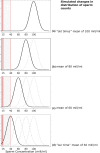Adverse trends in male reproductive health: we may have reached a crucial 'tipping point'
- PMID: 18194282
- PMCID: PMC2440492
- DOI: 10.1111/j.1365-2605.2007.00853.x
Adverse trends in male reproductive health: we may have reached a crucial 'tipping point'
Abstract
Healthy men produce an enormous number of sperms, far more than necessary for conception. However, several studies suggest that semen samples where the concentration of sperms is below 40 mill/mL may be associated with longer time to pregnancy or even subfertility, and specimens where the concentration of sperms is below 15 mill/mL may carry a high risk of infertility. Historic data from the 1940s show that the bulk of young men at that time had sperm counts far above 40 mill/mL with averages higher than 100 mill/mL. However, recent surveillance studies of young men from the general populations of young men in Northern Europe show that semen quality is much poorer. In Denmark approximately 40 percent of the men have now sperm counts below 40 mill/mL. A simulation assuming that average sperm count had declined from 100 mill/mL in 'old times' to a current level close to 40 mill/mL indicated that the first decline in average sperm number of 20-40 mill/mL might not have had much effect on pregnancy rates, as the majority of men would still have had counts far above the threshold value. However, due to the assumed decline in semen quality, the sperm counts of the majority of 20 year old European men are now so low that we may be close to the crucial tipping point of 40 mill/mL spermatozoa. Consequently, we must face the possibility of more infertile couples and lower fertility rates in the future.
Figures



References
-
- Adami H O, Bergström R, Möhner M, Zatonski W, Storm H, Ekbom A, et al. Testicular cancer in nine Northern European countries. International Journal of Cancer. 1994;59:33–38. - PubMed
-
- Andersen A N, Erb K. Register data on assisted reproductive technology (ART) in Europe. Including a detailed description of ART in Denmark. International Journal of Andrology. 2006;29:12–16. - PubMed
-
- Andersen A G, Jensen T K, Carlsen E, Jørgensen N, Andersson A M, Krarup T, Keiding N, Skakkebæk N E. High frequency of sub-optimal semen quality in an unselected population of young men. Human Reproduction. 2000;15:366–372. - PubMed
-
- Andersson A M, Jensen T K, Juul A, Petersen J H, Jørgensen T, Skakkebæk N E. Secular decline in male testosterone and sex hormone binding globuline serum levels in danish population surveys. Journal of Clinical Endocrinology and Metabolism. 2007 in press. - PubMed
-
- Boisen K A, Kaleva M, Main K M, Virtanen H E, Haavisto A M, Schmidt I M, et al. Difference in prevalence of congenital cryptorchidism in infants between two Nordic countries. Lancet. 2004;363:1264–1269. - PubMed
Publication types
MeSH terms
LinkOut - more resources
Full Text Sources

